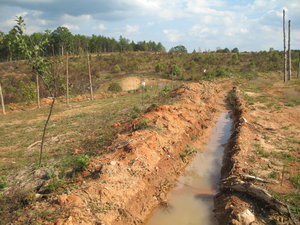Capturing, Directing and Holding Water
We're lucky enough to get plenty of rainfall; however, it is feast or famine with our heaviest rainfall in the spring and drought conditions during the heat of summer. We have a total of seven ponds, ranging from 18' deep and a half acre to small frog or pocket ponds. Luckily, our terrain is quite hilly, with just over 300' variance from the highest to the lowest point, which allows all of these to be filled with rain runoff. There's also a lot of natural water on our land; there’s a small forest river, a creek that bisects the land, and with our holding water on the land for as long as possible, seasonal springs now run all year and new springs pop up with regularity. I will never steal water from the natural water ways and although we do hold rain runoff, all of the ponds eventually overflow into the river and creek. It's a responsible cycle and has greatly benefited the farm and the forest that surrounds. us. We use swales to catch runoff as well as serving as gateways for responsible irrigation by either filling the swales from our stocked ponds (great sustainable fertilizer) or flood irritation.
Our farm is broken into two separate areas, divided by a natural windbreak of conifers. The gardens near our homestead are gently sloping while the cultivated area on the other side of the trees is more extremely sloped. I'm going to address the more dramatic area since it demanded a very deliberate approach and serious earthworks.
Let me first start with our soil, or compacted clay with little to no humus or topsoil. Personally, I love beginning with clay since it is packed with natural nutrients and holds its form as well as water. This area is approximately 12 acres, about a third of it has been reforested (a topic for later) and the remainder has multiple rolling hills. These hills, which vary in the extremity of curve, fold into one another, thus creating a perfect low spot for a rather large catchment pond, which has been stocked with fish. The largest of the hills is approximately five acres and has the most exaggerated slope. We deeply terraced this, with the terraces 14' deep and 18' between the different levels. On the edge of each terrace, we dug deep swales, about one foot square, and mounded the soil on the down slope creating large berms. The berms were planted with fruit trees, berry bushes and guilds - a process still being implemented as the soil is still being built up and organic matter is still being added to what was once only clay. Rainfall runoff from the upper slope of each terrace fills the swales and provides the perfect slow soak into the berms and slopes below. When we hit drought season, a pump is dropped into the catchment pond and the swales are manually filled with rich, stocked pond water. It takes less than an hour from start to finish to fill all of the swales and almost a week for the slow healthy soak to empty them.
On the edge of this terraced hill, where it relaxes into a gentle roll, we planted a swath of mulberries. During installation, we gave each young sapling a personal swale and berm with overflow outlets on each side. This allows modest rainfall collection or during drought season, allows us to flood irrigation this entire garden. Using the pond and pump, water is simply banked off a piece of wood and the entire area is flooded. Individual swales are perfectly filled, excess overflows downhill to the neighboring berries, and then that excess overflows to the pasture's swales. Not a wasted drop.
Mikayla directing the irrigation hose into a swale. The runoff catchment pond (stocked with fish) is below.
Deep swales on the edge of the terrace with small fruit trees and guilds were planted just below the berm, and berries planted on the top of the berm. This picture was taken three days after the swales were filled. You can see the waterline reflecting how deep the water was and how there is still plenty left to slowly soak the ground below.
This young mulberry patch is planted between the terraced hill and the future pasture.
Water pumped from the catchment pond is banked off of a piece of wood to gently flood irrigate the mulberry patch.
The individual swales for each mulberry fill up and the overflow moves below to fill up the pasture swales.





